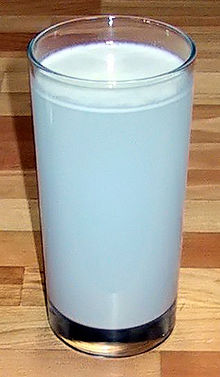
In chemistry, a suspension is a homogeneous fluid containing solid particles that are sufficiently large for sedimentation. Usually they must be larger than 1 micrometre.[1] The internal phase (solid) is dispersed throughout the external phase (fluid) through mechanical agitation, with the use of certain excipients or suspending agents. Unlike colloids, suspensions will eventually settle. An example of a suspension would be sand in water. The suspended particles are visible under a microscope and will settle over time if left undisturbed. This distinguishes a suspension from a colloid in which the suspended particles are smaller and do not settle.[2] In a solution, the dissolved substance does not exist as a solid and the two are homogeneously mixed
A suspension of liquid droplets or fine solid particles in a gas is called an aerosol. In the atmosphere these consist of fine dust and soot particles, sea salt, biogenic and volcanogenic sulfates, nitrates, and cloud droplets.
Suspensions are classified on the basis of the dispersed phase and the dispersion medium, where the former is essentially solid while the latter may either be a solid, a liquid or a gas.





